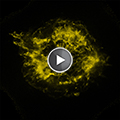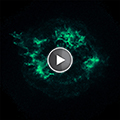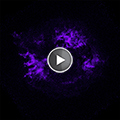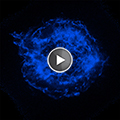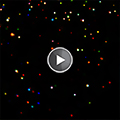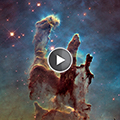CXC Home | Search | Help | Image Use Policy | Latest Images | Privacy | Accessibility | Glossary | Q&A
Download this video (MP4)
Galactic Center Sonification
(Credit: NASA/CXC/SAO/K.Arcand, SYSTEM Sounds (M. Russo, A. Santaguida))
[Runtime: 01:04]
 Audio Only Versions
Audio Only Versions
Sonification is the process that translates data into sound, and a new project brings the center of the Milky Way to listeners for the first time. The translation begins on the left side of the image and moves to the right, with the sounds representing the position and brightness of the sources. The light of objects located towards the top of the image are heard as higher pitches while the intensity of the light controls the volume. Stars and compact sources are converted to individual notes while extended clouds of gas and dust produce an evolving drone. The crescendo happens when we reach the bright region to the lower right of the image. This is where the 4-million-solar-mass supermassive black hole at the center of the Galaxy, known as Sagittarius A* (A-star), resides, and where the clouds of gas and dust are the brightest.
Users can listen to data from this region, roughly 400 light years across, either as "solos" from NASA's Chandra X-ray Observatory, Hubble Space Telescope, and Spitzer Space Telescope, or together as an ensemble in which each telescope plays a different instrument. Each image reveals different phenomena happening in this region about 26,000 light years from Earth. The Hubble image outlines energetic regions where stars are being born, while Spitzer's infrared data show glowing clouds of dust containing complex structures. X-rays from Chandra reveal gas heated to millions of degrees from stellar explosions and outflows from Sagittarius A*.
(Credit: NASA/CXC/SAO/K.Arcand, SYSTEM Sounds (M. Russo, A. Santaguida))
[Runtime: 01:04]
 Audio Only Versions
Audio Only Versions
Sonification is the process that translates data into sound, and a new project brings the center of the Milky Way to listeners for the first time. The translation begins on the left side of the image and moves to the right, with the sounds representing the position and brightness of the sources. The light of objects located towards the top of the image are heard as higher pitches while the intensity of the light controls the volume. Stars and compact sources are converted to individual notes while extended clouds of gas and dust produce an evolving drone. The crescendo happens when we reach the bright region to the lower right of the image. This is where the 4-million-solar-mass supermassive black hole at the center of the Galaxy, known as Sagittarius A* (A-star), resides, and where the clouds of gas and dust are the brightest.
Users can listen to data from this region, roughly 400 light years across, either as "solos" from NASA's Chandra X-ray Observatory, Hubble Space Telescope, and Spitzer Space Telescope, or together as an ensemble in which each telescope plays a different instrument. Each image reveals different phenomena happening in this region about 26,000 light years from Earth. The Hubble image outlines energetic regions where stars are being born, while Spitzer's infrared data show glowing clouds of dust containing complex structures. X-rays from Chandra reveal gas heated to millions of degrees from stellar explosions and outflows from Sagittarius A*.
Download this video (MP4)
Cassiopeia A Sonification
(Credit: NASA/CXC/SAO/K.Arcand, SYSTEM Sounds (M. Russo, A. Santaguida))
[Runtime: 00:21]
 Audio Only Versions
Audio Only Versions
In Cas A, the sounds are mapped to four elements found in the debris from the exploded star as well as other high-energy data. The distribution of silicon (red), sulfur (yellow), calcium (green), and iron (purple) are revealed moving outward from the center of the remnant, starting from the location of the neutron star, in four different directions, with intensity again controlling the volume. There is also another version with fifth audio path moving along the upper left jet.
(Credit: NASA/CXC/SAO/K.Arcand, SYSTEM Sounds (M. Russo, A. Santaguida))
[Runtime: 00:21]
 Audio Only Versions
Audio Only Versions
In Cas A, the sounds are mapped to four elements found in the debris from the exploded star as well as other high-energy data. The distribution of silicon (red), sulfur (yellow), calcium (green), and iron (purple) are revealed moving outward from the center of the remnant, starting from the location of the neutron star, in four different directions, with intensity again controlling the volume. There is also another version with fifth audio path moving along the upper left jet.
Download this video (MP4)
M16 Sonification
(Credit: NASA/CXC/SAO/K.Arcand, SYSTEM Sounds (M. Russo, A. Santaguida))
[Runtime: 00:21]
 Audio Only Versions
Audio Only Versions
In the "Pillars of Creation" piece, the sounds are generated by moving horizontally across the image from left to right as seen in both optical and X-ray light. As with the sonification of the Galactic Center, the vertical position of the recorded light controls the pitch, but in this case it varies over a continuous range of pitches. Particular attention is paid to the structure of the pillars which can be heard as sweeps from low to high pitches and back. The two different "melodies" of optical and X-ray light can be enjoyed individually or simultaneously.
(Credit: NASA/CXC/SAO/K.Arcand, SYSTEM Sounds (M. Russo, A. Santaguida))
[Runtime: 00:21]
 Audio Only Versions
Audio Only Versions
In the "Pillars of Creation" piece, the sounds are generated by moving horizontally across the image from left to right as seen in both optical and X-ray light. As with the sonification of the Galactic Center, the vertical position of the recorded light controls the pitch, but in this case it varies over a continuous range of pitches. Particular attention is paid to the structure of the pillars which can be heard as sweeps from low to high pitches and back. The two different "melodies" of optical and X-ray light can be enjoyed individually or simultaneously.
Download this video (MP4)
A Tour of Data Sonification: Sounds from Around the Milky Way
(Credit: NASA/CXC/A. Hobart)
[Runtime: 02:48]
With closed-captions (at YouTube)
The center of our Milky Way galaxy is too distant for us to visit in person, but we can still explore it. Telescopes gives us a chance to see what the Galactic Center looks like in different types of light. By translating the inherently digital data captured by telescopes in space into images, astronomers create visual representations that would otherwise be invisible to us.
But what about experiencing these images with other senses like hearing? Sonification is the process that translates data into sound, and a new project brings the center of the Milky Way to listeners for the first time. As the bar moves from left to right across the image, the sounds represent the position and brightness of the sources detected by NASA's Chandra X-ray Observatory, Hubble Space Telescope, and Spitzer Space Telescope. The light of objects located towards the top of the image are heard as higher pitches while the intensity of the light controls the volume. Each type of light reveals different phenomena in this region, which is roughly 400 light years across at a distance of about 26,000 light years from Earth. The supermassive black hole at the center of the Galaxy, called Sagittarius A*, resides in the bright region to the lower right of the image.
In addition to the Galactic Center, this team has also produced sonified versions of the remains of a supernova called Cassiopeia A, or Cas A, and the "Pillars of Creation" located in Messier 16. Sonification projects like this allow different audiences — including blind and visually-impaired communities — to explore space through data.
(Credit: NASA/CXC/A. Hobart)
[Runtime: 02:48]
With closed-captions (at YouTube)
The center of our Milky Way galaxy is too distant for us to visit in person, but we can still explore it. Telescopes gives us a chance to see what the Galactic Center looks like in different types of light. By translating the inherently digital data captured by telescopes in space into images, astronomers create visual representations that would otherwise be invisible to us.
But what about experiencing these images with other senses like hearing? Sonification is the process that translates data into sound, and a new project brings the center of the Milky Way to listeners for the first time. As the bar moves from left to right across the image, the sounds represent the position and brightness of the sources detected by NASA's Chandra X-ray Observatory, Hubble Space Telescope, and Spitzer Space Telescope. The light of objects located towards the top of the image are heard as higher pitches while the intensity of the light controls the volume. Each type of light reveals different phenomena in this region, which is roughly 400 light years across at a distance of about 26,000 light years from Earth. The supermassive black hole at the center of the Galaxy, called Sagittarius A*, resides in the bright region to the lower right of the image.
In addition to the Galactic Center, this team has also produced sonified versions of the remains of a supernova called Cassiopeia A, or Cas A, and the "Pillars of Creation" located in Messier 16. Sonification projects like this allow different audiences — including blind and visually-impaired communities — to explore space through data.
Download this video (MP4)
A Quick Look at Data Sonification: Sounds from Around the Milky Way
(Credit: NASA/CXC/A. Hobart)
[Runtime: 1:12]
Would you like to "listen" to the center of the Milky Way?
A new project takes images from NASA's Chandra X-ray Observatory and other telescopes and turns them into sounds.
This process, called sonification, translates the positions and brightness in the telescopes' images into different intensities and volumes.
Sonification allows different audiences — including blind and visually-impaired communities — to explore space through data.
The new sonification project has also turned images from the supernova remnant Cassiopeia A and the "Pillars of Creation" into sounds.
(Credit: NASA/CXC/A. Hobart)
[Runtime: 1:12]
Would you like to "listen" to the center of the Milky Way?
A new project takes images from NASA's Chandra X-ray Observatory and other telescopes and turns them into sounds.
This process, called sonification, translates the positions and brightness in the telescopes' images into different intensities and volumes.
Sonification allows different audiences — including blind and visually-impaired communities — to explore space through data.
The new sonification project has also turned images from the supernova remnant Cassiopeia A and the "Pillars of Creation" into sounds.
Audio Only Versions (Downloads)
| MP3 | OGG | M4R | |
|---|---|---|---|
| All Wavelengths | .mp3 | .ogg | .m4r |
| X-ray Only | .mp3 | .ogg | .m4r |
| Optical Only | .mp3 | .ogg | .m4r |
| Infrared Only | .mp3 | .ogg | .m4r |
| MP3 | OGG | M4R | |
|---|---|---|---|
| All Wavelengths | .mp3 | .ogg | .m4r |
| Silicon | .mp3 | .ogg | .m4r |
| Sulfur | .mp3 | .ogg | .m4r |
| Calcium | .mp3 | .ogg | .m4r |
| Iron | .mp3 | .ogg | .m4r |
| Blast Wave High Energy | .mp3 | .ogg | .m4r |
| MP3 | OGG | M4R | |
|---|---|---|---|
| All Wavelengths | .mp3 | .ogg | .m4r |
| X-ray Only | .mp3 | .ogg | .m4r |
| Optical Only | .mp3 | .ogg | .m4r |
Return to Data Sonification: Sounds from Around the Milky Way (September 22, 2020)





